|
| |
- Species in this family are parasitic wasps which there larvae parasite on soil insects
such as burrowing beetles
larvae and mole crickets. The female Flower Wasps has to burrow through the soil
to find the host and lay an egg on it. The female legs are modified for
digging and her wings are lost.
-
- However, she, like the male wasp, are feed on
nectar and has to visit the flowers. Wingless is a big disadvantage. They evolved
a mating behaviour which the male help the female. Their mating time is very
long. It is common to see a male Flower Wasp carrying a wingless female, with
tail to tail attached, flying between flowers. The transportation is part of
the mating procedures.
- Female flower wasps will sting if disturbed.
-
-
- Yellow Flower Wasp
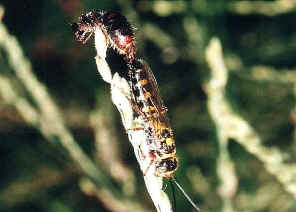
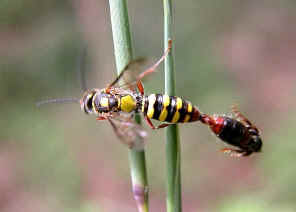 - Agriomyia or Hemithynnus sp., winged male 20mm, windless female 15mm
- We took those pictures when the winged male carrying the non-winged female
flying between grasses while they were mating. More information and pictures
please check this page.
-
-
- Black Flower Wasp
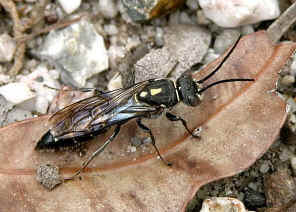
 - Agriomyia sp., winged male 20mm, windless female 10mm
- It is common to see a male Flower Wasp carrying a wingless female, with
tail to tail attached, flying between flowers. On Dec 2006, we saw a male
Flower Wasp it was searching for something under a dry leaf. It found a
female. Please check this page for more
information.
-
-
- Flower Wasp
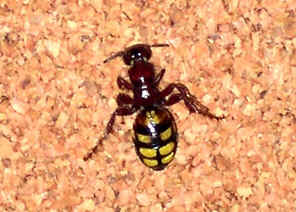 - Photo: Tony
Nye, Acacia Ridge
- Catocheilus sp., (synonym : Hemithynnus
sp.), wingless female body length
20mm
- Tony Nye in Acacia Ridge sent us this picture. This is a wingless female
Flower Wasp. Notice its strong legs which evolved for digging in soil. Flower
wasps are parasitic wasps which there larvae parasite on soil insects
such as burrowing beetles
larvae and mole crickets. The female Flower Wasps burrow through the soil
to find the host and lay an egg on it.
-
-
- Flower Wasp
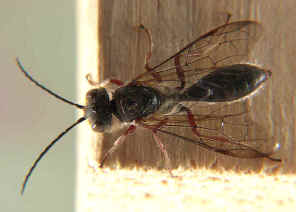 - Photo: Keith Power, Toowoomba
- Tachynomyia adusta, Thynninae male.
- Here we would like to thank Professor Denis Brothers
sending us email advised that this wasp is in the TIPHIIDAE
family. We had wrongly identified it is a Tachyphron aculeatus.
- Reference:
- 1. Tachyphron aculeatus
- - Insects of Townsville, Australia, Graeme Cocks, 2004.
-
-
- Unknown Black Wasp with yellow antenna
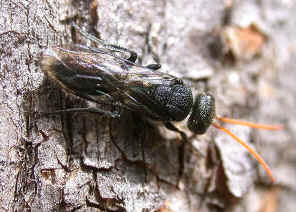
 - ? sp., body length 20mm
- This wasp is commonly seen searching on tree trunk. It is black in colour
with yellow antenna.
-
-
-
- Here we would like to thank Graham Brown again for sending us
emails to correct some of our mistakes in this page.
- Reference:
- 1. Insects
of Australia, CSIRO, Division of Entomology, Melbourne University
Press, 2nd Edition 1991, pp 977.
- 2. Insects of Australia and New Zealand - R. J. Tillyard, Angus
& Robertson, Ltd, Sydney, 1926, p293.
-
[ Up ] [ FAMILY POMPILIDAE ] [ Family Mutillidae ] [ FAMILY TIPHIIDAE ] [ FAMILY SCOLIIDAE ] [ FAMILY VESPIDAE ] [ FAMILY SPHECIDAE ] [ Other Predatory Wasps ]
|








